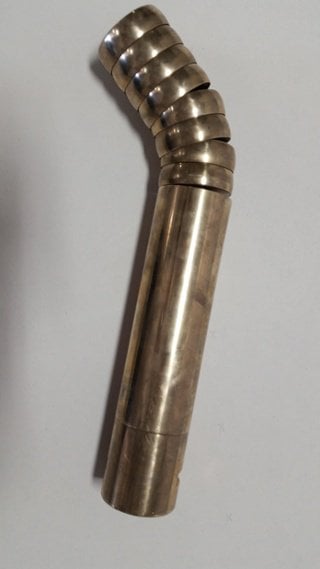While it is not always necessary to use a ball mandrel and wiper die when bending tubing, small radiuses, and thin walls sometimes mean a wiper die and ball mandrel are called for.
Why Use a Ball Mandrel and Wiper Die?

In fact, the pressure of this type of bend is so intense that the material is squeezed back past the tangent and buckles. A wiper die supports the material so that it can compress rather than buckle, and a ball mandrel supports it throughout the bend.
What are a Ball Mandrel and Wiper Die?
Mandrels are used to help maintain the shape of the tube as it sets into the arc of the bend. They provide support to the inside of the tube and can help to prevent buckling and necking.
Ball mandrels are the most complex of the mandrel assemblies, plug mandrels are the simplest.
Ball mandrels are used to internally support the tube beyond the tangent and, depending on the number of ball segments, through the entire bend.
Wiper dies are used when the tube's resistance to compression is high. These dies are primarily used to prevent wrinkling during the bend.
How to Bend Tubing with a Tube Bender, Ball Mandrel, and Wiper Die
Planning is the first step to successfully bending tubing with a ball mandrel and wiper die. The material you will be bending should be given special consideration, and, if possible, the entire material should be sourced from one supplier, even the same lot or heat number, if possible. This will help maintain the consistency of the tubing dimensions and characteristics.
Carefully consider the machine you will be using. The bending machine should be in good condition and operated by an experienced operator. Your tooling should likewise be of the highest quality. In fact, poor quality tooling leads to longer set-up times, more scrap, poorly bent tubes, and unacceptable bends.
When performing this type of bend, the piece of tooling most needs to be accurate is the wiper die. The groove through which the tube slides must be slightly larger than the O.D. of the tube, ñ 10% of wall thickness as being minimum. The groove must be of high polish lubricated with thin oil. Too much oil or too heavy oil in this area will cause wrinkles.
Wiper die fit to bend die groove must be 85% contact from 12:00 o'clock to 6:00 o'clock and for at least 15-20 degrees back from tangent. When the bend die does not support the wiper die at this point, it will spring away from the mandrel and cause the tube to wrinkle.
Learn More
Click here or follow the link below to download a free introduction to tube bending to learn more, troubleshoot bending problems, or contact us at any time with any questions or comments you may have.
